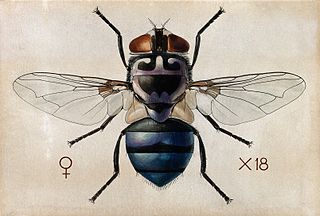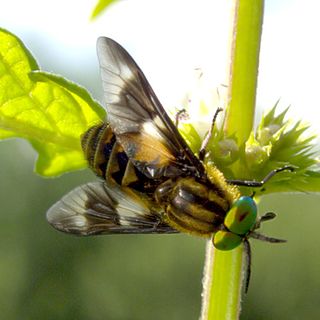
Heinrich Georg Bronn was a German geologist and paleontologist. He was the first to translate Charles Darwin's On the Origin of Species into German in 1860, although not without introducing his own interpretations, as also a chapter critiquing the work.

The Pentastomida are an enigmatic group of parasitic arthropods commonly known as tongue worms due to the resemblance of the species of the genus Linguatula to a vertebrate tongue; molecular studies point to them being degenerate crustaceans.

Karl (Carl) Moriz (Moritz) Diesing was an Austrian naturalist and zoologist, specializing in the study of helminthology.

Amedeo John Engel Terzi was an Italian illustrator and entomologist specialising in Diptera, the true flies.
Richard Heymons was a German zoologist and entomologist.

Superfamily Tabanoidea are insects in the order Diptera.
Eutrombicula hirsti, commonly called the scrub-itch mite, is a species of mite in the family Trombiculidae. It is found in northern Australia.

Linguatula serrata is a species of cosmopolitan zoonotic parasite, belonging to the tongueworm order Pentastomida. They are wormlike parasites of the respiratory systems of vertebrates. They live in the nasopharyngeal region of mammals. Cats, dogs, foxes, and other carnivores are normal hosts of this parasite. Apparently, almost any mammal is a potential intermediate host.

Linguatulosis is a condition associated with the organism Linguatula serrata.
Porocephaliasis is a condition associated with species in the closely related genera Porocephalus and Armillifer.

Armillifer armillatus is a species of tongue worm in the subclass Pentastomida occurring in tropical Africa. Its typical definitive hosts are pythons, such as the African rock python, while rodents are presumed to act as intermediate hosts. Humans may become accidentally infected by the eggs particularly if consuming infected snakes. Ingested eggs develop into nymphs that invade different visceral organs causing a disease called porocephalosis. Humans have been infected by eating undercooked snake meat or through direct contact. Most human infections are asymptomatic, some are debilitating, or rarely even lethal. Diagnoses of infection has usually been done by accident, and almost all patients did not require treatment.

Armillifer grandis is a species of tongue worm in the subclass Pentastomida found in tropical Central and West Africa. Its typical definitive hosts are viperid snakes, while rodents are presumed to act as intermediate hosts. Humans may become accidentally infected by the eggs, particularly if consuming infected snakes. Ingested eggs develop into nymphs that invade different visceral organs, causing a disease that is often called porocephalosis. Most human infections are asymptomatic, some are debilitating, or rarely even lethal. Abdominal infections are more widespread, but typically undiagnosed, while ocular manifestations are rare and may cause blindness.
Paraperipatus is a genus of velvet worms in the family Peripatopsidae. They are found in New Guinea and Maluku, Indonesia.

Louis Westenra Sambon was an Italian-English physician who played important roles in understanding the causes (etiology) of diseases. He described many pathogenic protozoans, insects, and helminths including the name Schistosoma mansoni for a blood fluke. He was an authority on the classification of parasitic tongue worms called Pentastomida (Linguatulida), and one of the genus Sambonia is named after him.

Porocephalida is an order of tongue worms. Some species in this order, such as Armillifer grandis, have been found in vipers, with some found in vipers from bushmeat markets.
Raillietiella teagueselfi is a species of parasitic crustacean. They are found in tropical and sub-tropical regions and affect the lungs of reptiles. The species was named after Dr. John Teague Self, a zoologist from the University of Oklahoma, for his contributions on Pentastomida.

Porocephalidae is a family of crustaceans belonging to the order Porocephalida.
Cephalobaena is a genus of crustaceans in the subclass Pentastomida. It has only one species, Cephalobaena tetrapoda, and is the only genus in the monotypic order Cephalobaenida, and the family Cephalobaenidae .
Reighardiidae is a family of crustaceans belonging to the subclass Pentastomida. It is the only family in the monotypic order Reighardiida.

Pangoniinae is a subfamily of Horse-flies in the order Diptera, containing at least four tribes and 24 genera.











